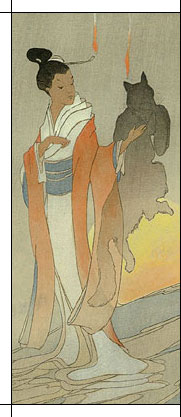
|
+ |
|
|
+ |
|
|
+ |
|
|
Western |
+ |
|
Vulpines |
+ |
|
+ |
|
|
+ |
|
|
That's not what they meant... |
+ |
|
Graves, roofs, and your own living room |
+ |
|
+ |
|
|
Where next? |
+ |
|
|
|

The Unwritten Rules of Fox SpiritsFox spirits, like all mythological creatures, operate according to rules. Some of these rules are openly stated: "Foxes can take on human form when they reach a certain age" and "foxes are afraid of dogs," for example. And some are unstated—authors never come out and write them because they're part of the culture, and the authors themselves may not be conscious of them. Those are the tricky rules, the important ones, the ones that are hardest to dig out and the ones that stories hinge upon. These rules are incomplete, and are true only for Chinese and Japanese foxes.
Attempting to trick a human is a killing offense. If a fox appears before a human in disguise, it can safely be assumed to be up to no good, and can be killed without fear of reprisal. This is most common in Japan, where trickster foxes can even be eaten. Not all foxes need to fear death, and not all humans who meet foxes in human form try to kill them, but humans who kill foxes for trickery are never brought to task. Foxes are outside human society, and their affairs make no permanent change to humanity. This is true even of foxes who married human men and were respected members of society. If a fox-wife flees her human in-laws, taking her human child with her, no one goes after her; if a fox-wife dies and it becomes known that she was a fox, the surface of society seems to shiver, then glaze neatly over the hole where she had been. This may be because... Foxes who take on human form are not expected to remain in human society for long. Fox scholars and fox priests are always discovered; fox companions leave their human friends out of disgust, or die suddenly, or move away; Japanese stories of fox wives end with the wife's early exile from the home; Chinese stories of fox wives end with the wife's early death or exile, or are cut too short for the reader to have any assurance that the marriage is going to last. Foxes' existences in human society are built on illusions that are expected to eventually fail, or crafted in abandoned corners that are eventually reclaimed by their human owners. Foxes themselves are often light, transitory creatures—the wandering priest, the scholar who drifts into town to take part in the latest contest, the mysterious maiden who comes to the door in the night, the succubus who drains her lovers dry and tosses them aside—so their very natures ensure that they will not stay in one place for long. Humans know and expect this, so when they discover that someone is a fox, they are willing to excuse almost any behavior as long as the fox takes itself and its unsettling habits out of town. Foxes and humans agree that humanity is a preferable state and that humans are superior to foxes. This is part of the Buddhist karmic ladder, in which souls migrate up and down the evolutionary chain according to their spiritual merit and the pinnacle of the chain is Homo sapiens. Foxes have a sort of informal class system. At the bottom are the babbling, lunkheaded would-be tricksters who try to steal rice balls from humans and wind up in fox soup for their troubles. At the top are the graceful, elegant scholars and scholarly maidens whose sophistication makes human scholars' heads spin. In between these peasants and aristocrats are the fox maidens who marry farmers and happily become farm wives, the crafty fox-men who become human men's drinking companions, and all the rest of the mass of foxes. This is truly an unwritten rule because no fox story ever juxtaposes, say, a rice-thief fox with a scholar-fox, and no character, fox or human, ever alludes to a class difference between foxes, but it's clear in the way different foxes are characterized. Foxes cannot physically harm humans. In story after story, humans beat, rape, even kill foxes, and the best the foxes can do is... struggle. If they're lucky, they can escape, but they don't get to come back swinging. In one story, a slighted fox rounds up teams of fox "warriors" to attack the human man who refused to give the fox his daughter in marriage, but the foxes' swords are only reeds, and the skirmishes all end with no human injuries. If a fox wants to hurt a human, she or he must attack indirectly, through tricks, spells, and fire. The one exception is in the case of rape. Foxes can rape humans; the violence of subduing a human doesn't seem to count as physical harm. Angry foxes can set house fires. This is a Japanese belief that shows up in at least two translated stories. At least part of a fox's gift is always trash. Japanese foxes are particularly fond of transforming leaves. More to come... |